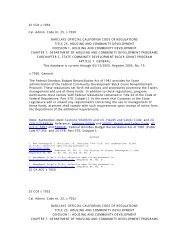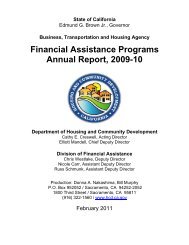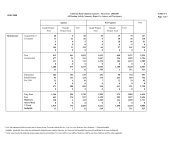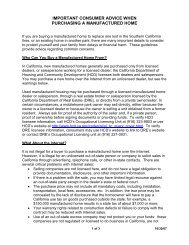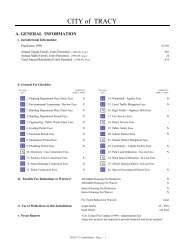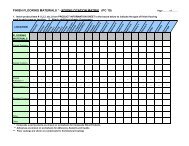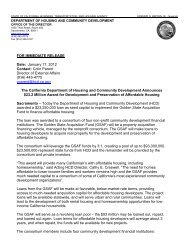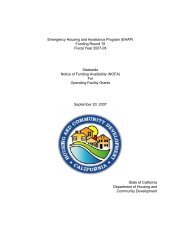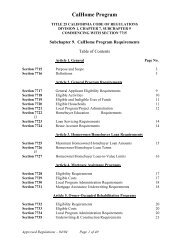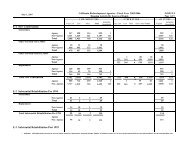Adobe PDF - California Department of Housing and Community ...
Adobe PDF - California Department of Housing and Community ...
Adobe PDF - California Department of Housing and Community ...
Create successful ePaper yourself
Turn your PDF publications into a flip-book with our unique Google optimized e-Paper software.
PUBLIC REVENUES - REGULATIONS <br />
If the property purchased under a certificate is used by the contractor in any other manner or for any other purpose<br />
than stated in the certificate, the contractor shall be liable for sales tax as if he or she were a retailer making a retail sale <strong>of</strong><br />
the property at the time <strong>of</strong> such use, <strong>and</strong> the sale price <strong>of</strong> the property to him or her shall be deemed the gross receipts<br />
from the sale.<br />
(C) Deductions for Tax-Paid Purchases Resold. A contractor may claim a “tax-paid purchases resold” deduction for<br />
any property <strong>of</strong> which he or she is the retailer when he or she has reimbursed his or her vendor for tax which the vendor is<br />
required to pay to the State or has paid the use tax with respect to the property, <strong>and</strong> has resold the property prior to<br />
making any use <strong>of</strong> it. In the event that the contractor sells short ends or pieces which are not used other than in severing<br />
them from larger units purchased by him or her <strong>and</strong> as to which he or she has paid sales tax reimbursement or use tax, he or<br />
she may claim the deduction for tax-paid purchases resold, but the amount <strong>of</strong> the deduction shall not exceed the price at<br />
which he or she sells such short ends or pieces.<br />
(c) Particular Applications.<br />
(1) Draperies <strong>and</strong> Drapery Hardware. Persons who contract to sell <strong>and</strong> install draperies including drapery<br />
hardware, such as brackets, rods, tracks, etc., are retailers <strong>of</strong> the items which they furnish <strong>and</strong> install. Tax applies to the<br />
entire contract price exclusive <strong>of</strong> the charge for installation which charge should be separately stated. Installers who<br />
furnish drapery hardware or other tangible personal property may accept resale certificates from department stores or<br />
other sellers to furnish <strong>and</strong> install the draperies <strong>and</strong> drapery hardware.<br />
The department stores or other sellers furnishing resale certificates are required to pay the tax to the state upon their<br />
selling price <strong>of</strong> the draperies <strong>and</strong> drapery hardware, exclusive <strong>of</strong> installation charges. The installer should segregate his<br />
or her installation charge in order that the department store or other seller may properly segregate its charge attributable<br />
to installation for purposes <strong>of</strong> determining its taxable gross receipts.<br />
(2) Prefabricated Cabinets. A cabinet will be considered to be “prefabricated” <strong>and</strong> a “fixture” when 90 percent <strong>of</strong> the<br />
total direct cost <strong>of</strong> labor <strong>and</strong> material in fabricating <strong>and</strong> installing the cabinet is incurred prior to affixation to the realty. In<br />
determining this 90 percent, the total direct cost <strong>of</strong> all labor <strong>and</strong> materials in fabricating the cabinet to the point <strong>of</strong><br />
installation will be compared to the total direct cost <strong>of</strong> all labor <strong>and</strong> materials in completely fabricating <strong>and</strong> installing the<br />
cabinet. If more than one cabinet is fabricated <strong>and</strong> installed under the contract, each cabinet will be considered separately in<br />
determining whether the cabinet is prefabricated.<br />
(3) Prefabricated Buildings. Prefabricated units such as commercial coaches, house trailers, etc., registered with the<br />
<strong>Department</strong> <strong>of</strong> Motor Vehicles or the <strong>Department</strong> <strong>of</strong> <strong>Housing</strong> <strong>and</strong> <strong>Community</strong> Development, are tangible personal<br />
property even though they may be connected to plumbing <strong>and</strong> utilities. A mobilehome which meets or is modified to meet, all<br />
applicable building codes <strong>and</strong> regulations <strong>and</strong> which is permanently affixed to realty, is an improvement to realty <strong>and</strong> is not<br />
personal property.<br />
A contract to furnish <strong>and</strong> install a prefabricated or modular building which is not a factory-built school building<br />
(relocatable classroom) is a construction contract whether the building rests in place by its own weight or is<br />
physically attached to realty. It is immaterial whether the building is erected upon or affixed to l<strong>and</strong> owned by the owner <strong>of</strong><br />
the building or is leased to the l<strong>and</strong>owner or lessee <strong>of</strong> the l<strong>and</strong>.<br />
Generally, a contract to furnish <strong>and</strong> install a small prefabricated building, such as a shed or kiosk, which is movable as<br />
a unit from its site <strong>of</strong> installation, is a construction contract only if the building is required to be physically attached to real<br />
property by the seller, upon a concrete foundation or otherwise. The sale <strong>of</strong> such a unit to rest in place by its own weight,<br />
whether upon the ground, a concrete slab, or sills or piers, is not a construction contract even though the seller may<br />
deliver the unit to its site <strong>of</strong> use.<br />
Prefabricated or modular buildings which are “factory-built housing” where permanently affixed to the realty are<br />
improvements to realty. The manufacturer <strong>of</strong> factory-built housing who contracts to furnish <strong>and</strong> install the factory-built housing<br />
manufactured by him or her is the consumer <strong>of</strong> the materials; used in building <strong>and</strong> installing the factory-built housing <strong>and</strong> the<br />
retailer <strong>of</strong> the fixtures. Tax applies as provided in (b) above.<br />
(4) Factory-built School Buildings.<br />
(A) General. On <strong>and</strong> after September 26, 1989, a contract to furnish <strong>and</strong> install a factory-built school building is not a<br />
construction contract but rather is a sale <strong>of</strong> tangible personal property.<br />
(B) Definitions.<br />
1. “Factory-built School Building.” The term “factory-built school building” (relocatable classroom) means <strong>and</strong><br />
includes:<br />
A. for the period September 26, 1989 through September 12, 1990, any building designed to be used as a school<br />
building as defined in sections 39214 <strong>and</strong> 81165 <strong>of</strong> the Education Code <strong>and</strong> so used. A factory-built school building must<br />
be designed in compliance with state laws for school construction <strong>and</strong> approved by the structural safety section in the<br />
<strong>of</strong>fice <strong>of</strong> the State Architect. It must be wholly or substantially manufactured at an <strong>of</strong>fsite location for the purpose <strong>of</strong><br />
being assembled, erected, or installed on a school site.<br />
B. effective September 13, 1990, any building which is designed or intended for use as a school building <strong>and</strong> is wholly<br />
or substantially manufactured at an <strong>of</strong>fsite location for the purpose <strong>of</strong> being assembled, erected, or installed on a site<br />
owned or leased by a school district or a community college district. A factory-built school building must be designed <strong>and</strong><br />
manufactured in accordance with building st<strong>and</strong>ards adapted <strong>and</strong> approved pursuant to chapter 4 (commencing with section<br />
18935) <strong>of</strong> part 2.5 <strong>of</strong> division 13 <strong>of</strong> the Health <strong>and</strong> Safety Code <strong>and</strong> must be approved by the structural safety section in<br />
the <strong>of</strong>fice <strong>of</strong> the State Architect.<br />
The term does not include buildings licensed by either the <strong>Department</strong> <strong>of</strong> Motor Vehicles or the <strong>Department</strong> <strong>of</strong> <strong>Housing</strong><br />
<strong>and</strong> <strong>Community</strong> Development. The term also does not include prefabricated or modular buildings which are similar in size<br />
to, but which are not, “factory-built school buildings”. It is immaterial whether the building is erected upon or affixed to l<strong>and</strong><br />
154



